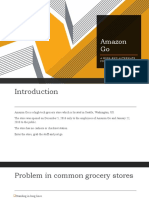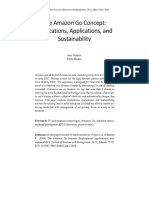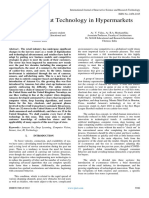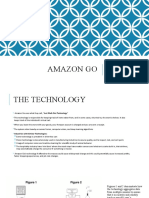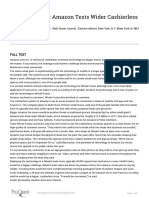Amazon Go: A Study of Checkout-Free Retail and AI Technology
Abstract
In recent years, Amazon has introduced a groundbreaking retail experience through its
Amazon Go stores, which have revolutionized the traditional shopping model. These stores,
now present across the United States and in London, offer a 'just walk out' shopping
experience, eliminating the need for registers and cashiers. This documentation explores what
Amazon Go is and how it operates.
Introduction
The retail landscape has seen significant transformations with the introduction of Amazon Go
stores, which offer a novel shopping experience. This paper delves into the workings of
Amazon Go stores, their innovative technology, and their potential impact on the future of
retail.
What is a 'just walk out' store?
Amazon describes its Amazon Go stores as "a new kind of store with no checkout required."
These stores are compact, typically around 1,800 square feet, and provide a seamless
shopping experience using the Amazon Go app for iOS or Android. Shoppers enter the store,
select their desired products, and exit without going through a conventional checkout process.
The app is linked to their Amazon account for billing.
In the United States, there are two types of Amazons Go stores:
- Amazon Go: Offering breakfast, lunch, and various snacks.
- Amazon Go Grocery: Providing produce, ready-made dinners, and household essentials.
In the United Kingdom, similar stores are branded as Amazon Fresh.
These stores rely on advanced technologies inspired by self-driving cars, including computer
vision, sensor fusion, and deep learning. These technologies detect when products are taken
�from or returned to the shelves, keeping track of them in the shopper's virtual cart. When
customers leave the store, their Amazon account is automatically charged, and they receive a
receipt.
Where can you find these stores?
As of now, there are over 25 Amazon Go stores in the United States, including the larger
Amazon Go Grocery stores. In the United Kingdom, Amazon operates 19 Fresh stores,
providing a mix of everyday essentials, local favourites, and seasonal items. Some stores also
offer ready-to-eat meals.
Reports suggest that the expansion may continue, with up to 30 stores planned for the UK.
Rumours indicate that Morrisons may be the launch partner, as Amazon Fresh stores offer an
extensive range of Amazon-branded grocery items. According to The Wall Street Journal,
Amazon's long-term vision involves opening as many as 2,000 grocery and convenience
stores, possibly with multiple formats.
How does it work?
To start shopping at Amazon, Go, customers need an Amazon account, a supported
smartphone, and the free Amazon Go app. Shoppers scan the app upon entering the store,
pass through a turnstile, and then start selecting items. They can place items in baskets or
bags without the need to scan each product individually. Once they've finished shopping, they
simply walk out; there's no traditional checkout process required.
The Amazon Go app features a navigation bar with tabs for Key, Receipts, About, and More.
The Key screen generates a QR code for the store's turnstiles, while the Receipt screen
displays a summary of items purchased after leaving the store.
'Just Walk Out' Technology
Amazon relies on a combination of artificial intelligence, computer vision, and data from
various sensors to ensure customers are accurately charged only for the items they take.
Cameras track items as they are removed from the shelves. An early patent application by
Amazon outlined a system of cameras, sensors, and RFID readers to identify shoppers and
their chosen products. The technology may also include facial recognition and user
information to enhance tracking and identification.
�Innovations and Future Directions
Amazon continues to innovate in the field of AI and machine learning to improve its retail
automation technologies. For instance, Just Walk Out has evolved to reduce the number of
required cameras, making it more cost-effective and capable of running algorithms locally.
Amazon's sensor and algorithm capabilities have expanded to accommodate different store
environments and customer behaviours.
Amazon also uses AI to offer personalized product recommendations. In Amazon Style, the
physical apparel store, customers receive diverse recommendations based on scanned
products. This system generates complementary selections to create complete outfits,
enhancing the shopping experience through machine learning algorithms.
The company has faced challenges with changing customer behaviours as its technology
scales. For instance, different shopping behaviours exist between smaller Amazon Go stores
and larger grocery stores, which require adaptability and continuous innovation in their
algorithms.
Conclusion
Amazon Go represents a significant advancement in the retail industry, offering a checkout-
free shopping experience through innovative AI and computer vision technologies. Amazon's
ongoing efforts in the field of AI are aimed at further enhancing the shopping experience and
expanding the reach of Just Walk Out technology. With ambitious plans for future growth,
Amazon continues to be at the forefront of AI-driven retail innovation.
References:
1. Towards Data Science Article
2. Amazon Jobs Listing
3. AI Business Article
4. Analytics India Mag Article
5. Silicon Angle Article
6. Pocket-Lint Article














